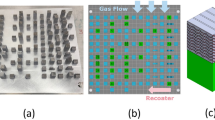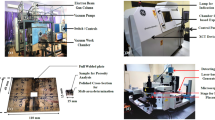Abstract
Porosity is a critical defect in laser powder bed fusion that limits the adoption of this technology. The variations in process parameters affect the level of porosity in additively manufactured parts. Due to the complex multiphysics of the laser powder bed fusion process, surrogate models can be used to predict the amount of porosity from the process parameters. Regression and machine learning approaches have been used for the porosity prediction. However, these models are developed for certain materials. This study compares different surrogate models for correlating the amount of porosity and the process parameters in combination with proposed dimensionless numbers that are dependent to both the process parameters and powder material properties. Regression, support vector machine, and neural networks models are trained using lack of fusion porosity synthetic data for three different materials. The results show that the support vector machine and the multi-layer neural network models that use process parameters and the dimensionless numbers as the independent variables can effectively predict the amount of porosity regardless of materials.




Similar content being viewed by others
Availability of data and material
The data that support the findings of this study are available from the corresponding author upon reasonable request.
Code availability
The code that supports the findings of this study is available from the corresponding author upon reasonable request.
References
Hopkinson N, Hague RJM, Dickens PM (2006) Rapid manufacturing: an industrial revolution for the digital age. John Wiley and Sons. https://doi.org/10.1002/0470033991
Bakshi KR (2016) A review on selective laser sintering: a rapid prototyping technology. IOSR J Mech Civ Eng 04:53–57. https://doi.org/10.9790/1684-15008040453-57
Kruth J-P, Wang X, Laoui T, Froyen L (2003) Lasers and Materials in Selective Laser Sintering. Assem Autom 23. https://doi.org/10.1108/01445150310698652
Goodridge RD, Tuck CJ, Hague RJM (2012) Laser sintering of polyamides and other polymers. Prog Mater Sci 57:229–267. https://doi.org/10.1016/j.pmatsci.2011.04.001
Ragulya AV (1998) Selective laser sintering. I. Principles and continual model. Poroshkovaya Metall. 37:16–26. https://doi.org/10.1007/bf02676015
Jiang J, Xu X, Stringer J (2018) Support structures for additive manufacturing: a review. J Manuf Mater Process 2. https://doi.org/10.3390/jmmp2040064
Malekipour E, El-Mounayri H (2018) Common defects and contributing parameters in powder bed fusion AM process and their classification for online monitoring and control: a review. Int J Adv Manuf Technol 95:527–550. https://doi.org/10.1007/s00170-017-1172-6
Malekipour E, El-Mounayri H (2018) Defects, process parameters and signatures for online monitoring and control in powder-based additive manufacturing. Conf Proc Soc Exp Mech Ser 9:83–90. https://doi.org/10.1007/978-3-319-62834-9_12
Kumar S (2003) Selective laser sintering: A qualitative and objective approach. Jom 55:43–47. https://doi.org/10.1007/s11837-003-0175-y
Zhang B, Li Y, Bai Q (2017) Defect formation mechanisms in selective laser melting: a review, Chinese. J Mech Eng 30:515–527. https://doi.org/10.1007/s10033-017-0121-5
Asgharzadeh H, Simchi A (2005) Effect of sintering atmosphere and carbon content on the densification and microstructure of laser-sintered M2 high-speed steel powder. Mater Sci Eng A 403:290–298. https://doi.org/10.1016/j.msea.2005.05.017
Hilaire A, Andrieu E, Wu X (2019) High-temperature mechanical properties of alloy 718 produced by laser powder bed fusion with different processing parameters. Addit Manuf 26:147–160. https://doi.org/10.1016/j.addma.2019.01.012
Donik Č, Kraner J, Paulin I, Godec M (2020) Influence of the energy density for selective laser melting on the microstructure and mechanical properties of stainless steel. Metals (Basel) 10. https://doi.org/10.3390/met10070919
Dursun G, Ibekwe S, Li G, Mensah P, Joshi G, Jerro D (2020) Influence of laser processing parameters on the surface characteristics of 316L stainless steel manufactured by selective laser melting. Mater Today Proc 26:387–393. https://doi.org/10.1016/j.matpr.2019.12.061
Read N, Wang W, Essa K, Attallah MM (2015) Selective laser melting of AlSi10Mg alloy: process optimisation and mechanical properties development. Mater Des 65:417–424. https://doi.org/10.1016/j.matdes.2014.09.044
Carter LN, Wang X, Read N, Khan R, Aristizabal M, Essa K, Attallah MM (2016) Process optimisation of selective laser melting using energy density model for nickel based superalloys. Mater Sci Technol 32:657–661. https://doi.org/10.1179/1743284715Y.0000000108
Gu D, Shen Y (2008) Processing conditions and microstructural features of porous 316L stainless steel components by DMLS. Appl Surf Sci 255:1880–1887. https://doi.org/10.1016/j.apsusc.2008.06.118
Irrinki H, Jangam JSD, Pasebani S, Badwe S, Stitzel J, Kate K, Gulsoy O, Atre SV (2018) Effects of particle characteristics on the microstructure and mechanical properties of 17–4 PH stainless steel fabricated by laser-powder bed fusion. Powder Technol 331:192–203. https://doi.org/10.1016/j.powtec.2018.03.025
Zhang S, Lane B, Whiting J, Chou K (2019) On thermal properties of metallic powder in laser powder bed fusion additive manufacturing. J Manuf Process 47:382–392. https://doi.org/10.1016/j.jmapro.2019.09.012
Wang P, Lei H, Zhu X, Chen H, Fang D (2019) Influence of AlSi10Mg particles microstructure on heat conduction during additive manufacturing. Int J Heat Mass Transf 144:118632. https://doi.org/10.1016/j.ijheatmasstransfer.2019.118632
Wang W, Ning J, Liang SY (2021) Analytical prediction of balling, lack-of-fusion and keyholing thresholds in powder bed fusion. Appl Sci 11. https://doi.org/10.3390/app112412053
Wang W, Liang SY (2021) Physics-based predictive model of lack-of-fusion porosity in laser powder bed fusion considering cap area. Cryst 11. https://doi.org/10.3390/cryst11121568
Ning J, Wang W, Zamorano B, Liang SY (2019) Analytical modeling of lack-of-fusion porosity in metal additive manufacturing. Appl Phys A 125:797. https://doi.org/10.1007/s00339-019-3092-9
Garg A, Tai K, Savalani MM (2014) State-of-the-art in empirical modelling of rapid prototyping processes. Rapid Prototyp J 20:164–178. https://doi.org/10.1108/RPJ-08-2012-0072
Chatterjee AN, Kumar S, Saha P, Mishra PK, Choudhury AR (2003) An experimental design approach to selective laser sintering of low carbon steel. J Mater Process Technol 136:151–157. https://doi.org/10.1016/S0924-0136(03)00132-8
Beal VE, Paggi RA, Salmoria GV, Lago A (2009) Statistical evaluation of laser energy density effect on mechanical properties of polyamide parts manufactured by selective laser sintering. J Appl Polym Sci 113:2910–2919. https://doi.org/10.1002/app.30329
Ning Y, Fuh JYH, Wong YS, Loh HT (2004) An intelligent parameter selection system for the direct metal laser sintering process. Int J Prod Res 42:183–199. https://doi.org/10.1080/00207540310001595873
Li X, Dong J, Zhang Y (2009). Modeling and applying of RBF neural network based on fuzzy clustering and pseudo-inverse method. https://doi.org/10.1109/ICIECS.2009.5362683
Cong-Zhong C, Jun-Fang P, Yu-Feng W, Xing-Jian Z, Ting-Ting X (2009) Density prediction of selective laser sintering parts based on support vector regression. Acta Phys Sin 58. https://doi.org/10.7498/aps.58.8
Imani F, Gaikwad A, Montazeri M, Rao P, Yang H, Reutzel E (2018) Process mapping and in-process monitoring of porosity in laser powder bed fusion using layerwise optical imaging. J Manuf Sci Eng 140. https://doi.org/10.1115/1.4040615
Aminzadeh M, Kurfess TR (2019) Online quality inspection using Bayesian classification in powder-bed additive manufacturing from high-resolution visual camera images. J Intell Manuf 30:2505–2523. https://doi.org/10.1007/s10845-018-1412-0
A.A.R. Ansys Additive Release (2021) R1 User’s Guide (Print and Science). Ansys Inc
Gong H, Rafi K, Gu H, Starr T, Stucker B (2014) Analysis of defect generation in Ti–6Al–4V parts made using powder bed fusion additive manufacturing processes. Addit Manuf 1–4:87–98. https://doi.org/10.1016/j.addma.2014.08.002
van Elsen M, Al-Bender F, Kruth J (2008) Application of dimensional analysis to selective laser melting. Rapid Prototyp J 14:15–22. https://doi.org/10.1108/13552540810841526
Mukherjee T, Manvatkar V, De A, DebRoy T (2017) Dimensionless numbers in additive manufacturing. J Appl Phys 121:64904. https://doi.org/10.1063/1.4976006
Balemans C, Hulsen MA, Anderson PD (2020) On the validity of 2D analysis of non-isothermal sintering in SLS. Chem Eng Sci 213:115365. https://doi.org/10.1016/j.ces.2019.115365
Wang Z, Liu M (2019) Dimensionless analysis on selective laser melting to predict porosity and track morphology. J Mater Process Technol 273:116238. https://doi.org/10.1016/j.jmatprotec.2019.05.019
Estrada-Díaz JA, Elías-Zúñiga A, Martínez-Romero O, Rodríguez-Salinas J, Olvera-Trejo D (2021) A mathematical dimensional model for predicting bulk density of Inconel 718 parts produced by selective laser melting. Mater 14. https://doi.org/10.3390/ma14030512
Kozak J, Zakrzewski T, Witt M, Dębowska-Wąsak M (2021) Selected problems of additive manufacturing using SLS/SLM processes. Trans Aerosp Res 2021:24–44. https://doi.org/10.2478/tar-2021-0003
Evans JH (1972) Dimensional analysis and the Buckingham Pi theorem. Am J Phys 40:1815–1822. https://doi.org/10.1119/1.1987069
Curtis WD, Logan JD, Parker WA (1982) Dimensional analysis and the pi theorem. Linear Algebra Appl 47:117–126. https://doi.org/10.1016/0024-3795(82)90229-4
Lindman HR (1992) Analysis of variance in experimental design. Springer-Verlag Publishing, New York, NY, US. https://doi.org/10.1007/978-1-4613-9722-9
Read N, Wang W, Essa K, Attallah MM (2015) Selective laser melting of AlSi10Mg alloy: process optimisation and mechanical properties development. Mater Des 65:417–424. https://doi.org/10.1016/J.MATDES.2014.09.044
Kruth J-P, Kumar S (2005) Statistical analysis of experimental parameters in selective laser sintering. Adv Eng Mater 7:750–755. https://doi.org/10.1002/adem.200500030
Liao H, Shie J (2007) Optimization on selective laser sintering of metallic powder via design of experiments method. Rapid Prototyp J 13:156–162. https://doi.org/10.1108/13552540710750906
Savalani MM, Hao L, Dickens PM, Zhang Y, Tanner KE, Harris RA (2012) The effects and interactions of fabrication parameters on the properties of selective laser sintered hydroxyapatite polyamide composite biomaterials. Rapid Prototyp J 18:16–27. https://doi.org/10.1108/13552541211193467
Wu CFJ, Hamada MS (2009) Experiments: planning, analysis, and optimization, 2nd edn. John Wiley & Sons
Funding
The support from the San Diego State University is gratefully acknowledged.
Author information
Authors and Affiliations
Corresponding author
Ethics declarations
Ethics approval
This research did not contain any studies involving animal or human participants, nor did it take place on any private or protected areas. No specific permissions were required for corresponding locations.
Consent to participate
Informed consent was obtained from all individual participants included in the study.
Consent for publication
The participant has consented to the submission of the case report to the journal.
Competing interests
The authors declare no competing interests.
Additional information
Publisher's Note
Springer Nature remains neutral with regard to jurisdictional claims in published maps and institutional affiliations.
Rights and permissions
Springer Nature or its licensor holds exclusive rights to this article under a publishing agreement with the author(s) or other rightsholder(s); author self-archiving of the accepted manuscript version of this article is solely governed by the terms of such publishing agreement and applicable law.
About this article
Cite this article
Escalona-Galvis, L.W., Kang, J.S. Comparative evaluation of parametric models of porosity in laser powder bed fusion. Int J Adv Manuf Technol 122, 3693–3701 (2022). https://doi.org/10.1007/s00170-022-10129-y
Received:
Accepted:
Published:
Issue Date:
DOI: https://doi.org/10.1007/s00170-022-10129-y




